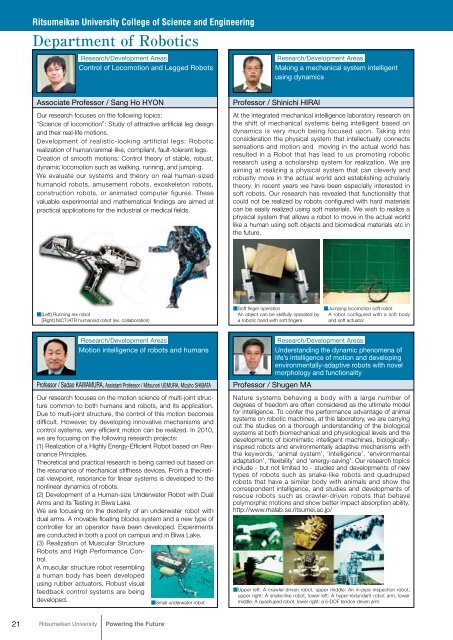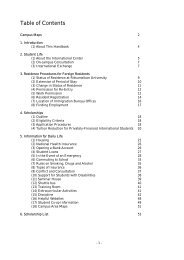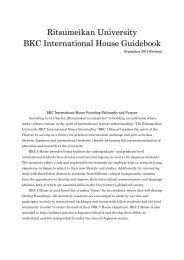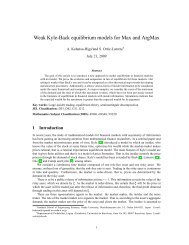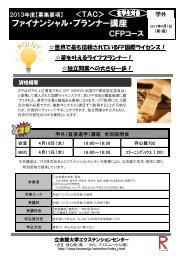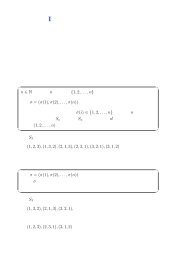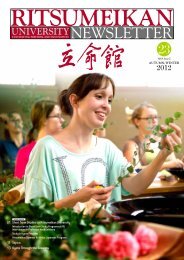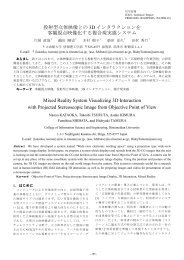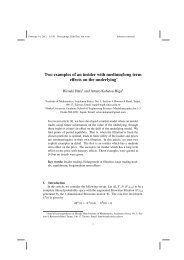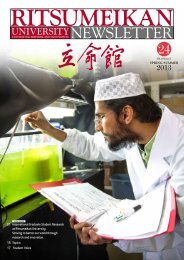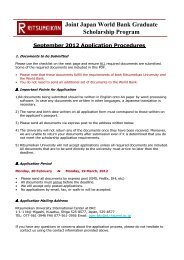Powering the Future - 立命館大学
Powering the Future - 立命館大学
Powering the Future - 立命館大学
You also want an ePaper? Increase the reach of your titles
YUMPU automatically turns print PDFs into web optimized ePapers that Google loves.
Ritsumeikan University College of Science and Engineering<br />
Department of Robotics<br />
Research/Development Areas<br />
Control of Locomotion and Legged Robots<br />
Research/Development Areas<br />
Making a mechanical system intelligent<br />
using dynamics<br />
Associate Professor / Sang Ho HYON<br />
Our research focuses on <strong>the</strong> following topics:<br />
“Science of locomotion”: Study of attractive artificial leg design<br />
and <strong>the</strong>ir real-life motions.<br />
Development of realistic-looking artificial legs: Robotic<br />
realization of human/animal-like, compliant, fault-tolerant legs.<br />
Creation of smooth motions: Control <strong>the</strong>ory of stable, robust,<br />
dynamic locomotion such as walking, running, and jumping.<br />
We evaluate our systems and <strong>the</strong>ory on real human-sized<br />
humanoid robots, amusement robots, exoskeleton robots,<br />
construction robots, or animated computer figures. These<br />
valuable experimental and ma<strong>the</strong>matical findings are aimed at<br />
practical applications for <strong>the</strong> industrial or medical fields.<br />
Professor / Shinichi HIRAI<br />
At <strong>the</strong> integrated mechanical intelligence laboratory research on<br />
<strong>the</strong> shift of mechanical systems being intelligent based on<br />
dynamics is very much being focused upon. Taking into<br />
consideration <strong>the</strong> physical system that intellectually connects<br />
sensations and motion and moving in <strong>the</strong> actual world has<br />
resulted in a Robot that has lead to us promoting robotic<br />
research using a scholarship system for realization. We are<br />
aiming at realizing a physical system that can cleverly and<br />
robustly move in <strong>the</strong> actual world and establishing scholarly<br />
<strong>the</strong>ory. In recent years we have been especially interested in<br />
soft robots. Our research has revealed that functionality that<br />
could not be realized by robots configured with hard materials<br />
can be easily realized using soft materials. We wish to realize a<br />
physical system that allows a robot to move in <strong>the</strong> actual world<br />
like a human using soft objects and biomedical materials etc in<br />
<strong>the</strong> future.<br />
■[Left] Running rex robot<br />
[Right] NICT/ATR humanoid robot (ex. collaboration)<br />
■Soft finger operation<br />
An object can be skillfully operated by<br />
a robotic hand with soft fingers<br />
■Jumping locomotion soft robot<br />
A robot configured with a soft body<br />
and soft actuator<br />
Research/Development Areas<br />
Motion intelligence of robots and humans<br />
Professor / Sadao KAWAMURA, Assistant Professor / Mitsunori UEMURA, Mizuho SHIBATA<br />
Our research focuses on <strong>the</strong> motion science of multi-joint structure<br />
common to both humans and robots, and its application.<br />
Due to multi-joint structure, <strong>the</strong> control of this motion becomes<br />
difficult. However, by developing innovative mechanisms and<br />
control systems, very efficient motion can be realized. In 2010,<br />
we are focusing on <strong>the</strong> following research projects:<br />
(1) Realization of a Highly Energy-Efficient Robot based on Resonance<br />
Principles.<br />
Theoretical and practical research is being carried out based on<br />
<strong>the</strong> resonance of mechanical stiffness devices. From a <strong>the</strong>oretical<br />
viewpoint, resonance for linear systems is developed to <strong>the</strong><br />
nonlinear dynamics of robots.<br />
(2) Development of a Human-size Underwater Robot with Dual<br />
Arms and its Testing in Biwa Lake.<br />
We are focusing on <strong>the</strong> dexterity of an underwater robot with<br />
dual arms. A movable floating blocks system and a new type of<br />
controller for an operator have been developed. Experiments<br />
are conducted in both a pool on campus and in Biwa Lake.<br />
(3) Realization of Muscular Structure<br />
Robots and High Performance Control.<br />
A muscular structure robot resembling<br />
a human body has been developed<br />
using rubber actuators. Robust visual<br />
feedback control systems are being<br />
developed.<br />
■Small underwater robot<br />
Research/Development Areas<br />
Understanding <strong>the</strong> dynamic phenomena of<br />
life’s intelligence of motion and developing<br />
environmentally-adaptive robots with novel<br />
morphology and functionality<br />
Professor / Shugen MA<br />
Nature systems behaving a body with a large number of<br />
degrees of freedom are often considered as <strong>the</strong> ultimate model<br />
for intelligence. To confer <strong>the</strong> performance advantage of animal<br />
systems on robotic machines, at this laboratory, we are carrying<br />
out <strong>the</strong> studies on a thorough understanding of <strong>the</strong> biological<br />
systems at both biomechanical and physiological levels and <strong>the</strong><br />
developments of biomimetic intelligent machines, biologicallyinspired<br />
robots and environmentally adaptive mechanisms with<br />
<strong>the</strong> keywords, ‘animal system’, ‘intelligence’, ‘environmental<br />
adaptation’, ‘flexibility’ and ‘energy-saving’. Our research topics<br />
include - but not limited to - studies and developments of new<br />
types of robots such as snake-like robots and quadruped<br />
robots that have a similar body with animals and show <strong>the</strong><br />
correspondent intelligence, and studies and developments of<br />
rescue robots such as crawler-driven robots that behave<br />
polymorphic motions and show better impact absorption ability.<br />
http://www.malab.se.ritsumei.ac.jp/<br />
■Upper left: A crawler-driven robot, upper middle: An in-pipe inspection robot,<br />
upper right: A snake-like robot, lower left: A hyper-redundant robot arm, lower<br />
middle: A quadruped robot, lower right: a 5-DOF tendon-driven arm<br />
21 Ritsumeikan University <strong>Powering</strong> <strong>the</strong> <strong>Future</strong>


